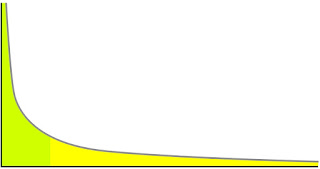Despite protestations that we all should have a fair shake in life, in fact, the most goes to the fewest. Power, wealth, and success are highly concentrated in a small number of individuals, compared to the multitude of the masses. These painful facts influence our businesses, as well. Even in a group of successful entrepreneurs, you'll find a few near the top and a whole lot somewhere else.
Undoubtedly, the power curve applies in the architecture, engineering and construction industry. Look at the numbers in the ENR Top 400 and see who is at the top, and who is at the bottom. Then realize that these are the top 400 -- obviously most contractors would consider themselves to be near the pinnacle if they could get anywhere near that level.
Ironically, the Internet has redefined and increased the power curve's impact. In the "old days," some markets would be simply too small and specialized to serve effectively. You really couldn't make money publishing a book unless you sold a few thousand copies, at least. Now, well, you won't make much, but you won't lose much either, with just a few dozen sales or less.
My book on social media and construction marketing, for example, had a "hard cost" of about $120.00. I went out on a limb and spent $100 on the cover design, and another $20 for the services of a specialized e-book formatter. Of course, the book required some time and effort to write, but I'm a writer, anyways. In the last week, the book has sold four copies at $4.95 each. After Amazon takes its cut, the net revenue is about $ 3.45. So, if sales continue at present levels, the book will hit "break even" in about three months. Of course the net revenue at the end of the year will be about a whopping $600.00.
The question is: How do you apply the power curve effectively in your business? It is generally unwise to put all of your eggs into one basket, especially one big and powerful client. (The biggest successes in business these days, like Google and Facebook, are, of course, skyrocketing on the power curve because of their ability to reach deeply into its lower levels.) One answer is to think about big and small in somewhat different balances. Realize you can capture micro-niches and own the market for tiny relationship groups. The individual revenue potential for these groups and niches may be small, but they can open the doors to bigger things.
Another concept which I've been exploring is the application of concentrated, seemingly irrational energy, in places where you can stretch and defy the power curve's norms. As an example, I certainly have a tiny AdSense account, not quite at the bottom of a really long tail, but certainly nowhere near the top. And yet I have phone numbers, personal email addresses, and amazing connections within Mountain View because of some odds-defying decisions to help out as a volunteer in a space few wish to tread.
We won't all be at the level of Bill Gates or Barack Obama but I think we can all discover some excellence and areas where we stretch to the heights of the power curve within special interest groups or niches. When we can, we'll achieve marketing and business success.
You can share your power curve success stories here, if you wish, through the comments function.
Calculate Your Cost Per Lead
-
When you calculate your cost per lead, you'll know what you need to spend
on marketing to meet your sales goals.
3 years ago










No comments:
Post a Comment